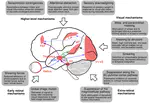sensorimotor contingency
Temporal recalibration is a fascinating phenomenon. If one (experimentally) induces a consistent artificial delay between an action (e.g., pressing a button) and a visual stimulus (e.g., the light turning on), then - after a few exposures - stimuli occuring at shorter delays may well appear as if they happened even before the action was executed. In this piece Wiebke shows temporal recalibration across a good range of visual conditions with not only real but also simulated saccades.
To efficiently explore our visual environment, we humans incessantly make brief and rapid eye movements. These so-called saccades inevitably shift the entire visual image across the retina, thereby inducing - like a moving camera with long exposure duration - a significant amount of motion blur, transforming single objects into elongated smeared motion streaks. While simultaneously recording electroencephalography and eye tracking, we asked human observers to make saccades to a target stimulus which then rapidly changed location while their eyes were in mid-flight. Critically, we compared smooth target motion to a simple jump, thus isolating neural responses and behavioral benefits specific to motion streaks. For continuous motion (i.e., when streaks were available), the post-saccadic target location could be decoded earlier from electrophysiological data and secondary saccades went more quickly to the new target location. Indeed, decoding of target location succeeded immediately after the end of the saccade and was most efficient on occipital sensors, suggesting that saccade-induced motion streaks are represented in visual cortex. Computational modeling of saccades as a consequence of early visual processes suggests that fast motion could be efficiently coded in orientation-selective channels, providing a parsimonious mechanism by which the brain exploits motion streaks for goal-directed behavior.
In this paper, we report a mysterious finding. When detecting rapid stimulus motion of a Gabor stimulus oriented orthogonal to its motion direction, it is not simply its absolute velocity that determines its visibility, but a combination of velocity and movement distance. Curiously, the specific combination that predicts velocity thresholds follows an oculomotor law, that is, the main sequence, an exponential function describing the increase of saccadic velocity with growing amplitude. My proud contributions to this paper feature the masking experiment, the modeling of saccade trajectories which ultimately revealed significant correlations between saccade metrics and velocity thresholds, and most importantly, the early vision model to predict the measured psychophysical data, without fitting and based only on the trajectory of the stimulus. Finally, I evaluated the timing of the motion stimulus using photometric measurements using the LM03 lightmeter.




